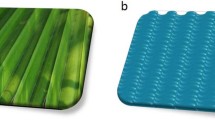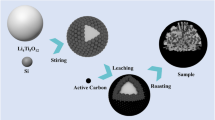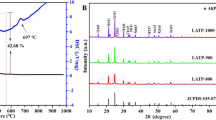Abstract
Spinel lithium titanate (Li4Ti5O12, LTO), with the merits of safety operation voltage, stable crystal structure, and minor lattice volume changes, becomes an optimal anode material for high-power Li-ion batteries. However, the inherent wide bandgap and low lithiation reactivity of Li4Ti5O12 bring about poor conductivity and lithiation dynamics, limiting its further applications. Herein, we design and prepare unique Li4Ti5O12 anode materials with extremely low dopant content of Na+ utilizing the amorphous precursors. The resultant Li4Na0.008Ti5O12.004 sample (denoted as NLTO-0.008) presents superior rate performances and cycle ability, with a reversible capacity of 149.4 mAh·g−1 at the current rate of 10.0C. NLTO-0.008 retains the charge capacity of 151.3 mAh·g−1 with a capacity loss of 0.5% after 1000 cycles at the current rate of 1.0C (charge) /10.0C (discharge). The kinetic studies furtherly demonstrate that the lithiation reaction energy and diffusion energy barrier decrease by 28.8% and 30%, respectively. Crystal structure analysis indicates that Na+ occupies the 16d Li site and forms distorted LiO4 tetrahedron and TiO6 octahedron. This lattice distortion forms open diffusion channels, thus enhancing the Li+ diffusion dynamics and decreasing the lithiation reaction energy barrier for Li4Ti5O12. Therefore, the pre-sodiation strategy may arouse great interest in understanding and developing intercalation-type transition-metal-based electrode materials in high-power lithium-ion batteries.
Graphical abstract

摘要
尖晶石钛酸锂(Li4Ti5O12)具有工作电压安全、晶体结构稳定、晶格体积变化小等优点,是高功率锂离子电池理想的负极材料之一。然而,由于本征带隙宽和锂化反应性低,Li4Ti5O12的导电性低和电化学极化严重,限制了其进一步的应用。为此,本文基于非晶钛氧化物前驱体,利用预钠化策略设计并制备了钠掺杂量极其低的Li4Ti5O12负极材料,并表现出优异的倍率性能和循环性能。Li4Na0.008Ti5O12.004样品(标记为NLTO-0.008)在10C倍率下充放电,可逆容量达149.4 mAh·g-1。NLTO-0.008甚至在1C(充电)/10C(放电)电流密度下,1000次循环后仍保持151.3 mAh·g-1的放电比容量,容量仅损失0.5%。动力学研究表明,NLTO-0.008的锂化反应能垒和扩散能垒分别降低了28.8%和30%。晶体结构分析表明,Na+选择性占据Li4Ti5O12的16d Li位,诱导LiO4四面体和TiO6八面体晶格畸变。扭曲的晶格结构,提供了开放的Li+扩散通道,进而降低Li4Ti5O12的反应/扩散能垒的。因此,本文采用的预钠化策略对于理解和开发高功率锂离子电池嵌入型过渡金属基电极材料具有重要意义。





Similar content being viewed by others
References
Zhang X, Ju ZY, Zhu Y, Takeuchi KJ, Takeuchi ES, Marschilok AC, Yu GH. Multiscale understanding and architecture design of high energy/power lithium-ion battery electrodes. Adv Energy Mater. 2021;11(2):2000808. https://doi.org/10.1002/aenm.202000808.
Yu J, Meng BC, Wang LJ, Wang Q, Huang WL, Wang XY, Fang Z. Depositing natural stibnite on 3D TiO2 nanotube array networks as high-performance thin-film anode for lithium-ion batteries. Rare Met. 2021;40(11):3215. https://doi.org/10.1007/s12598-020-01658-0.
Griffith KJ, Wiaderek KM, Cibin G, Marbella LE, Grey CP. Niobium tungsten oxides for high-rate lithium-ion energy storage. Nature. 2018;559(7715):556. https://doi.org/10.1038/s41586-018-0347-0.
Zhang H, Yang Y, Xu H, Wang L, Lu X, He XM. Li4Ti5O12 spinel anode: fundamentals and advances in rechargeable batteries. InfoMat. 2021. https://doi.org/10.1002/inf2.12228.
Jin HC, Xin S, Chuang CH, Li WD, Wang HY, Zhu J, Xie HY, Zhang TM, Wan YY, Qi ZK, Yan WS, Lu YR, Chan TS, Wu XJ, Goodenough JB, Ji HX, Duan XF. Black phosphorus composites with engineered interfaces for high-rate high-capacity lithium storage. Science. 2020;370(6513):192. https://doi.org/10.1126/science.aav5842.
Lou SF, Zhao Y, Wang JJ, Yin GP, Du CY, Sun XL. Ti-based oxide anode materials for advanced electrochemical energy storage: lithium/sodium ion batteries and hybrid pseudocapacitors. Small. 2019;15(52):1904740. https://doi.org/10.1002/smll.201904740.
Zhang ZJ, Zhao J, Qiao ZJ, Wang JM, Sun SH, Fu WX, Zhang XY, Yu ZY, Dou YH, Kang JL, Yuan D, Feng YZ, Ma JM. Nonsolvent-induced phase separation-derived TiO2 nanotube arrays/porous Ti electrode as high-energy-density anode for lithium-ion batteries. Rare Met. 2021;40(2):393. https://doi.org/10.1007/s12598-020-01571-6.
Tang YX, Zhang YY, Li WL, Ma B, Chen XD. Rational material design for ultrafast rechargeable lithium-ion batteries. Chem Soc Rev. 2015;44(17):5926. https://doi.org/10.1039/c4cs00442f.
He YS, Muhetaer A, Li JM, Wang FF, Liu C, Li Q, Xu DS. Ultrathin Li4Ti5O12 nanosheet based hierarchical microspheres for high-rate and long-cycle life Li-ion batteries. Adv Energy Mater. 2017;7(21):1700950. https://doi.org/10.1016/j.ensm.2019.05.036.
Wang YQ, Gu L, Guo YG, Li H, He XQ, Tsukimoto S, Ikuhara Y, Wan LJ. Rutile-TiO2 nanocoating for a high-rate Li4Ti5O12 anode of a lithium-ion battery. J Am Chem Soc. 2012;134(18):7874. https://doi.org/10.1021/ja301266w.
Wang DD, Liu HD, Li MQ, Wang XF, Bai S, Shi Y, Tian JH, Shan ZQ, Meng YS, Liu P, Chen Z. Nanosheet-assembled hierarchical Li4Ti5O12 microspheres for high-volumetric-density and high-rate Li-ion battery anode. Energy Storage Mater. 2019;21:361. https://doi.org/10.1016/j.ensm.2019.05.036.
Salvatore KL, Lutz DM, Guo HY, Yue SY, Gan J, Tong X, Liu P, Takeuchi ES, Takeuchi KJ, Marschilok AC, Wong SS. Solution-based, anion-doping of Li4Ti5O12 nanoflowers for lithium-ion battery applications. Chem Eur J. 2020;26(42):9389. https://doi.org/10.1002/chem.202002489.
Zheng LY, Wang XY, Xia YG, Xia SL, Metwalli E, Qiu B, Ji Q, Yin SS, Xie S, Fang K, Liang SZ, Wang MM, Zuo XX, Xiao Y, Liu ZP, Zhu J, Müller Buschbaum P, Cheng YJ. Scalable in situ synthesis of Li4Ti5O12/carbon nanohybrid with supersmall Li4Ti5O12 nanoparticles homogeneously embedded in carbon matrix. ACS Appl Mater Interfaces. 2018;10(3):2591. https://doi.org/10.1021/acsami.7b16578.
Zhang SY, Gao YY, Zhang ZB, Gu T, Liang XB, Wang LZ. Research progress on functional properties of novel high-entropy metallic glasses. Chin J Rare Met. 2021;45(6):717. https://doi.org/10.13373/j.cnki.cjrm.XY20080032.
Peng LL, Fang ZW, Zhu Y, Yan CS, Yu GH. Holey 2D nanomaterials for electrochemical energy storage. Adv Energy Mater. 2018;8(9):1702179. https://doi.org/10.1002/aenm.201702179.
Song H, Jeong TG, Yun SW, Lee EK, Park SA, Kim YT. An upper limit of Cr-doping level to retain zero-strain characteristics of Li4Ti5O12 anode material for Li-ion batteries. Sci Rep. 2017;7:43335. https://doi.org/10.1038/srep43335.
Yi TF, Shu J, Zhu YR, Zhu XD, Yue CB, Zhou AN, Zhu RS. High-performance Li4Ti5-xVxO12 (0<x<0.3) as an anode material for secondary lithium-ion battery. Electrochim Acta. 2009;54(28):7464. https://doi.org/10.1016/j.electacta.2009.07.082.
Pu ZY, Lan QY, Li YM, Liu SM, Yu DL, Lv XJ. Preparation of W-doped hierarchical porous Li4Ti5O12/brookite nanocomposites for high rate lithium ion batteries at –20 °C. J Power Sources. 2019;437:226890. https://doi.org/10.1016/j.jpowsour.2019.226890.
Song H, Jeong TG, Moon YH, Chun HH, Chung KY, Kim HS, Cho BW, Kim YT. Stabilization of oxygen-deficient structure for conducting Li4Ti5O12-δ by molybdenum doping in a reducing atmosphere. Sci Rep. 2014;4:4350. https://doi.org/10.1038/srep04350.
Yang GJ, Park SJ. Single-step solid-state synthesis and characterization of Li4Ti5-xFexO12-x (0 ≤ x ≤ 0.1) as an anode for lithium-ion batteries. J Mater Chem A. 2020;8(5):2627. https://doi.org/10.1039/c9ta12117j.
Zou HL, Liang X, Feng XY, Xiang HF. Chromium-modified Li4Ti5O12 with a synergistic effect of bulk doping, surface coating, and size reducing. ACS Appl Mater Interfaces. 2016;8(33):21407. https://doi.org/10.1021/acsami.6b07742.
Liu ZJ, Huang YD, Cai YJ, Wang XC, Zhang Y, Guo Y, Ding J, Cheng WH. Oxygen vacancy enhanced two-dimensional lithium titanate for ultrafast and long-life bifunctional lithium storage. ACS Appl Mater Interfaces. 2021;13(16):18876. https://doi.org/10.1021/acsami.1c02962.
Bai X, Li T, Bai YJ. Capacity degradation of Li4Ti5O12 during long-term cycling in terms of composition and structure. Dalton Trans. 2020;49(29):10003. https://doi.org/10.1039/d0dt01719a.
Wang NW, Huang ZC, Cui XM, Wu ZY. Effects of Mg2+ doping on performance of anode material Li4Ti5O12. Adv Mater Res. 2013;779:307. https://doi.org/10.4028/www.scientific.net/AMR.779-780.307.
Wang L, Zhang YM, Guo HY, Li J, Stach EA, Tong X, Takeuchi ES, Takeuchi KJ, Liu P, Marschilok AC, Wong SS. Structural and electrochemical characteristics of Ca-doped “flower-like” Li4Ti5O12 motifs as high-rate anode materials for lithium-ion batteries. Chem Mater. 2018;30(3):671. https://doi.org/10.1021/acs.chemmater.7b03847.
Yi TF, Yang SY, Li XY, Yao JH, Zhu YR, Zhu RS. Sub-micrometric Li4-xNaxTi5O12 (0 ≤ x ≤ 0.2) spinel as anode material exhibiting high rate capability. J Power Sources. 2014;246:505. https://doi.org/10.1016/j.jpowsour.2013.08.005.
Fu ST, Yu XF, Wu QL, Yang XF, Liu Z, Li XH, He SM, Wang D, Li YC, Tong SF, Wu MM. Ultrathin [110]-confined Li4Ti5O12 nanoflakes for high rate lithium storage. Adv Energy Mater. 2021;11(22):2003270. https://doi.org/10.1002/aenm.202003270.
Yuwono JA, Burr P, Galvin C, Lennon A. Atomistic insights into lithium storage mechanisms in anatase, rutile, and amorphous TiO2 electrodes. ACS Appl Mater Interfaces. 2021;13(1):1791. https://doi.org/10.1021/acsami.0c17097.
Lin ZJ, Mao ML, Yang CX, Tong YX, Li QH, Yue JM, Yang GJ, Zhang QH, Hong L, Yu XQ, Gu L, Hu YS, Li H, Huang XJ, Suo LM, Chen LQ. Amorphous anion-rich titanium polysulfides for aluminum-ion batteries. Sci Adv. 2021. https://doi.org/10.1126/sciadv.abg6314.
Yu L, Wu HB, Lou XW. Mesoporous Li4Ti5O12 hollow spheres with enhanced lithium storage capability. Adv Mater. 2013;25(16):2296. https://doi.org/10.1002/adma.201204912.
Deng CJ, Lau ML, Ma CR, Skinner P, Liu YZ, Xu WQ, Zhou H, Zhang XH, Wu D, Yin YD, Ren Y, Perez J, Jaramillo D, Barnes P, Hou DW, Dahl M, Williford B, Chong Z, Xiong H. A mechanistic study of mesoporous TiO2 nanoparticle negative electrode materials with varying crystallinity for lithium ion batteries. J Mater Chem A. 2020;8(6):3333. https://doi.org/10.1039/c9ta12499c.
Zhang ZC, Goodall JBM, Brown S, Karlsson L, Clark RJH, Hutchison JL, Rehmanb IU, Darr JA. Continuous hydrothermal synthesis of extensive 2D sodium titanate (Na2Ti3O7) nano-sheets. Dalton Trans. 2010;39(3):711. https://doi.org/10.1039/b915699b.
Zhang YP, Guo L, Yang SH. Three-dimensional spider-web architecture assembled from Na2Ti3O7 nanotubes as a high performance anode for a sodium-ion battery. Chem Commun. 2014;50(90):14029. https://doi.org/10.1039/c4cc06451h.
Assefa TA, Suzana AF, Wu LL, Koch RJ, Li LX, Cha WS, Harder RJ, Bozin ES, Wang F, Robinson IK. Imaging the phase transformation in single particles of the lithium titanate anode for lithium-ion batteries. ACS Appl Energy Mater. 2021;4(1):111. https://doi.org/10.1021/acsaem.0c02010.
Lee SH, Kim HK, Yun YS, Yoon JR, Lee SG, Lee YH. A novel high-performance cylindrical hybrid supercapacitor with Li4-xNaxTi5O12/activated carbon electrodes. Int J Hydrogen Energy. 2014;39(29):16569. https://doi.org/10.1016/j.ijhydene.2014.05.072.
Brauckmann JO, Verhoef RS, Schotman AH, Kentgens AP. Solid-state nuclear magnetic resonance characterization of residual 23Na in aramid fibers. J Phys Chem C. 2019;123(23):14439. https://doi.org/10.1021/acs.jpcc.9b02071.
Anjali K, Ajithkumar TG, Joy PA. Raman and 23Na solid-state NMR studies on the lead-free ferroelectrics Bi0.5(Na1-xKx)0.5TiO3 in the morphotropic phase boundary region. Mater Res Bull. 2019;118:110506. https://doi.org/10.1016/j.materresbull.2019.110506.
Skadtchenko BO, Trudeau M, Schurko RW, Willans MJ, Antonelli D. Structural and spectroscopic studies on mesoporous tantalum oxide-sodium fulleride composites with conducting fulleride columns in the pores. Adv Funct Mater. 2013;13(9):671. https://doi.org/10.1002/adfm.200304392.
Madsen RSK, Qiao A, Ivan Hung JS, Chen KZ, Gan ZH, Sen S, Yue YZ. Ultrahigh-field 67Zn NMR reveals short-range disorder in zeolitic imidazolate framework glasses. Science. 2020;367(6485):1473. https://doi.org/10.1126/science.aaz0251.
Terskikh VV, Lapina OB, Bondareva VM. Sodium-modified V2O5-TiO2 catalysts: 23Na and 51V solid-state NMR study. Phys Chem Chem Phys. 2000;2(10):2441. https://doi.org/10.1039/b001282n.
Dickinson LC, Macknight WJ, Connolly JM, Chien JCW. 23Na-NMR of solid state ionomers: lineshape, shift, and hydration effects. Polym Bull. 1987;17:459. https://doi.org/10.1007/bf00255619.
Lim KH, Grey CP. Characterization of extra-framework cation positions in zeolites NaX and NaY with very fast 23Na MAS and multiple quantum MAS NMR spectroscopy. J Am Chem Soc. 2000;122(40):9768. https://doi.org/10.1021/ja001281d.
Ma JM, Wei YP, Gan L, Wang C, Xia HY, Lv W, Li J, Li BH, Yang QH, Kang FY, He YB. Abundant grain boundaries activate highly efficient lithium ion transportation in high rate Li4Ti5O12 compact microspheres. J Mater Chem A. 2019;7(3):1168. https://doi.org/10.1039/c8ta10072a.
Liu X, Xiao LP, Weng J, Xu QC, Li WL, Zhao CH, Xu J, Zhao YL. Regulating the reactivity of black phosphorus via protective chemistry. Sci Adv. 2020. https://doi.org/10.1126/sciadv.abb4359.
Xiao CW, Ding Y, Zhang JT, Su XQ, Li GR, Gao XP, Shen PW. Li4-xNaxTi5O12 with low operation potential as anode for lithium ion batteries. J Power Sources. 2014;248:323. https://doi.org/10.1016/j.jpowsour.2013.09.131.
Yi TF, Yang SY, Li XY, Yao JH, Zhu YR, Zhu RS. Sub-micrometric Li4-xNaxTi5O12 (0 ≤ x ≤ 0.2) spinel as anode material exhibiting high rate capability. J Power Sources. 2014;246:505. https://doi.org/10.1016/j.jpowsour.2013.08.005.
Liu ZX, Sun LM, Yang WY, Yang JB, Han SB, Chen DF, Liu YT, Liu XF. The synergic effects of Na and K co-doping on the crystal structure and electrochemical properties of Li4Ti5O12 as anode material for lithium ion battery. Solid State Sci. 2015;44:39. https://doi.org/10.1016/j.solidstatesciences.2015.04.002.
Lu P, Huang XB, Ren YR, Ding JN, Wang HY, Zhou SB, Chen YD, Ding X. Na+ and Zr4+ co-doped Li4Ti5O12 as anode materials with superior electrochemical performance for lithium ion batteries. RSC Adv. 2016;6(93):90455. https://doi.org/10.1039/c6ra16717a.
Shen ZH, Zhang ZL, Li M, Yuan YF, Zhao Y, Zhang S, Zhong CL, Zhu J, Lu J, Zhang HG. Rational design of a Ni3N0.85 electrocatalyst to accelerate polysulfide conversion in lithium-sulfur batteries. ACS Nano. 2020;14(6):6673. https://doi.org/10.1021/acsnano.9b09371.
Xia JY, Hua WX, Wang L, Sun YF, Geng CN, Zhang C, Wang WC, Wan Y, Yang QH. Boosting catalytic activity by seeding nanocatalysts onto interlayers to inhibit polysulfide shuttling in Li-S batteries. Adv Funct Mater. 2021;31(26):2101980. https://doi.org/10.1002/adfm.202101980.
Zhu JF, Chen J, Xu H, Sun SQ, Xu Y, Zhou M, Gao X, Sun ZM. Plasma-introduced oxygen defects confined in Li4Ti5O12 nanosheets for boosting lithium-ion diffusion. ACS Appl Mater Interfaces. 2019;11(19):17384. https://doi.org/10.1021/acsami.9b02102.
Huang C, Zhao SX, Peng H, Lin YH, Nan CW, Cao GZ. Hierarchical porous Li4Ti5O12-TiO2 composite anode materials with pseudocapacitive effect for high-rate and low-temperature applications. J Mater Chem A. 2018;6(29):14339. https://doi.org/10.1039/c8ta03172j.
Hänggi P, Talkner P, Borkovec M. Reaction-rate theory: fifty years after kramers. Rev Mod Phys. 1990;62(2):251. https://doi.org/10.1103/RevModPhys.62.251.
Acknowledgements
This work was financially supported by the National Natural Science Foundation of China (No. 52002116) and the Key Science and Technology Program of Henan Province (No. 192102210004).
Author information
Authors and Affiliations
Corresponding author
Ethics declarations
Conflict of interests
The authors declare that they no conflict of interest.
Supplementary Information
Below is the link to the electronic supplementary material.
Rights and permissions
About this article
Cite this article
Zhang, YH., Nie, ZH., Du, CQ. et al. Ultrahigh lithiation dynamics of Li4Ti5O12 as an anode material with open diffusion channels induced by chemical presodiation. Rare Met. 42, 471–483 (2023). https://doi.org/10.1007/s12598-022-02135-6
Received:
Revised:
Accepted:
Published:
Issue Date:
DOI: https://doi.org/10.1007/s12598-022-02135-6




